Ernesto Padilla |
|

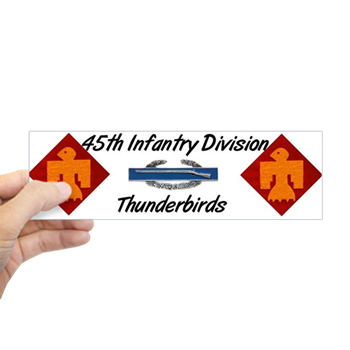
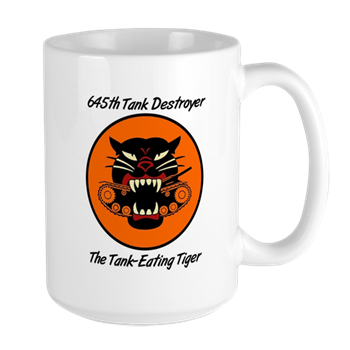
Interview with Ernesto Padilla | ||
Shrapnel ravaged Ernesto Padilla's knee; the New Mexican doesn't dwell on his misfortune but takes pride in his successes
| ||
The life of Ernesto Padilla is one marked with opportunities masked by tragedy. His childhood was spent with his large family in Puerto de Luna, N.M. The town, nestled on the Pecos River, was a community inhabited primarily by Latino ranchers and farmers. "My dad had a general store and a cattle ranch, so for my age I was pretty well enrolled in the activities that constitute farming and cattle ranching," Mr. Padilla said. Yet, farming was unable to offer all he wanted in life. "I always wanted to go to a big city where there (were) more opportunities to get a good job," he said. After his parents died while he was still a boy, he moved to Las Vegas, N.M., to live with his oldest sister at the age of 13. During the summers off from Las Vegas High School work was hard to find, especially for teenagers. Mr. Padilla earned money doing odd jobs and serving with the National Guard. It was the $50 paycheck for two weeks of service that first lured him into the military. "I used to read about how Germany was mobilizing . . . the time Hitler came to power," he said. "But I never realized there was going to be a war." In September 1940, after Mr. Padilla had graduated, the National Guard was federalized. His unit, Company F, 120th Engineer Combat Battalion, 45th Infantry Division, was sent to Fort Sill, Okla., for a year of training. In Oklahoma the mostly Latino outfit kept its distance from the local Anglo- and American Indian-dominated Company C. Over time, they mingled more frequently, but Mr. Padilla remembers feeling surrounded by strangers. Before the end of 1941, the United States entered World War II. Padilla's enlistment was almost up along with many others stationed at Camp Barkley, Texas. "I was getting ready to leave when I heard a lieutenant rush into our tent and announce that Pearl Harbor had been bombed," he said. "We knew we weren't going to be bored anymore." All discharges were canceled immediately and soldiers already on furlough were called back. Then came a staggered tour of military bases in Massachusetts, New York and Virginia. The reality
of war had finally hit home: "Pearl Harbor was a turning point for everybody,"
Mr. Padilla said.
| ||
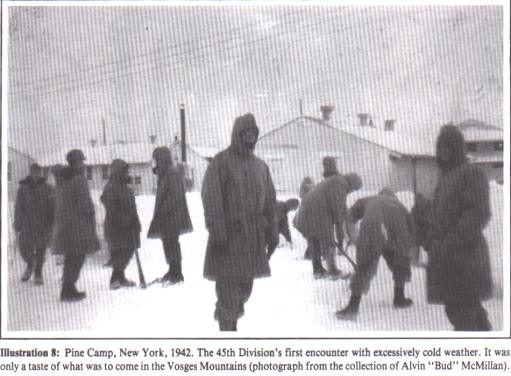 | ||
While in New York the soldiers geared up for cold weather, fighting and sleeping among snowdrifts reaching to 7 feet. Anticipating a dearth of resources, his battalion practiced varied techniques in bridge-building while in Camp Pickett, Va., constructing passages with wooden pegs instead of nails and sidestepping the laborious and noisy lumber-cutting process by using explosives instead of saw blades. With TNT "necklaces" strung around tree trunks, timber could be gathered quickly if conditions called for expediency over workmanship. The division finally left American soil, boarding the USS Caliber to a troop ship bound for Oran, Africa. From June 22 to July 4, 1943 they ran amphibious operation drills in preparation for Operation HUSKY, the Allied invasion of Sicily. Most of the soldiers were inexperienced in war, and were understandably nervous. "We knew we were (going to) be in an invasion," Mr. Padilla said. "But we didn't know exactly how dangerous it would be." The
Allies steadied their course in early July for the major ports of Augusta, Catania,
Palermo and Syracuse, on the southeastern and northwestern coasts of Sicily. | ||
| For
nearly three hours before Padilla's division shoved off, heavy naval gunfire on
the ship spat deafening rounds over their heads. Eventually, the troops descended
by ropes onto smaller crafts known as LSTs to make their way to the shore. Upon
landing, soldiers waded waist-deep through the water onto the beachhead, only
to find it empty. |
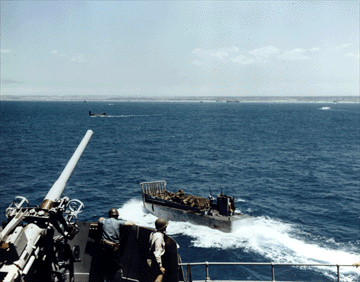 |
|
| "All
of a sudden, German machine guns started firing," sending soldiers to the
ground, Mr. Padilla said. Men dug foxholes to stay low until the attack subsided. He remembers watching a friend from Las Vegas getting torn in half by machine gun fire after standing up too soon. "After
I saw my friend die, we were getting more cautious," he said. "We learned
quite a bit in that first battle." The 45th Infantry went in
to Salerno to fill the gap between the British and the US 36th Infantry. After
several tense days the Allies moved inland. As they marched next from Callabria
to Benevento the combat engineers were under less protection from the infantry
than usual, as the path was relatively clear of opposition. Mr. Padilla recalls
that German fighters were near, but aside from the occasional aerial bombing,
nobody saw them. | ||
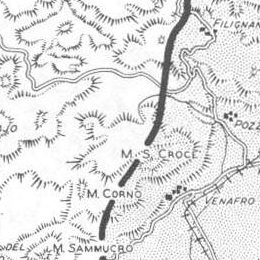 |
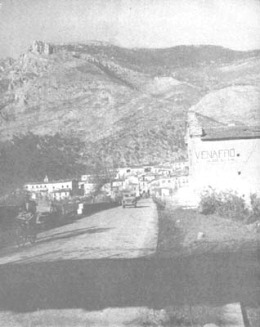 | |
| Spotting
Allied soldiers down the road, Mr. Padilla asked them how dangerous it would be
to build in Venafro. They told him the German forces had already retreated. Unbeknownst
to them, however, a tank armed with a 88-mm gun sat camouflaged on a nearby hill.
The tank soon announced its presence with a sound Mr. Padilla will never forget. "When there's an '88' flying over your head, it whistles, so immediately you hit the ground," Mr. Padilla said. All he remembers is that an unknown medic from one of the units saved his life. "The pain was so intense . . . there was nothing else I could think about except the pain," Mr. Padilla said. From the field he was rushed to an evacuation hospital and transferred to Vesuvius Army General Hospital. Shrapnel from the '88' took out his left kneecap and injured his hand. He was out of the war for good. After the war, Mr. Padilla was fitted with an artificial leg in Brigham City, Utah, after an amputation in Algiers during the war. After a long recuperation, he settled in California after his honorable discharge in 1946. Attending school with money from the GI Bill, Mr. Padilla found a career in the aircraft industry working for defense contractors such as Lockheed and McDonnell Douglas as well as for the federal government. Despite his disability, Mr. Padilla has lived a full life and now lives in the same house where he raised his four children. He is reflective of the ironic role tragic situations had in shaping his life. "(It)
changed my plans as to what I was going to do in life," Mr. Padilla said.
"It's a part of serving your country, if you don't do it, somebody else will
have to."
| ||
(Mr.
Padilla was interviewed by Brian Lucero in Albuquerque, N.N., on February 26,
2002.) | ||
last revision